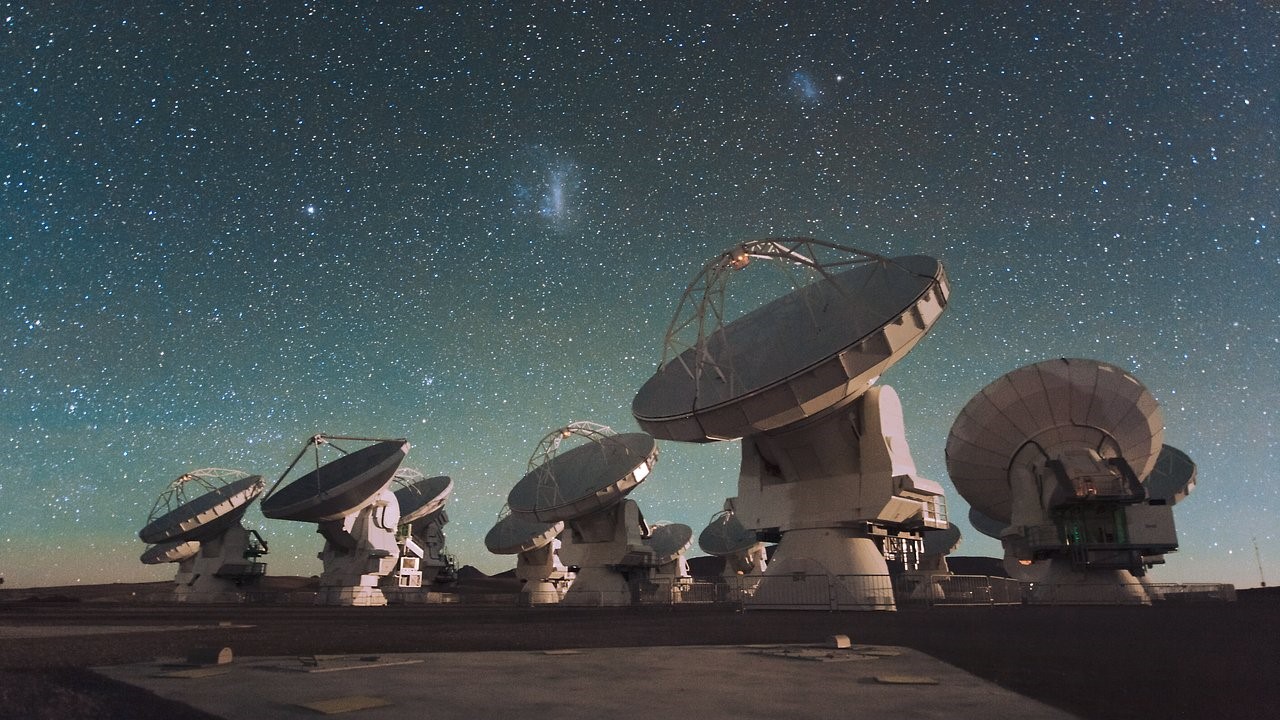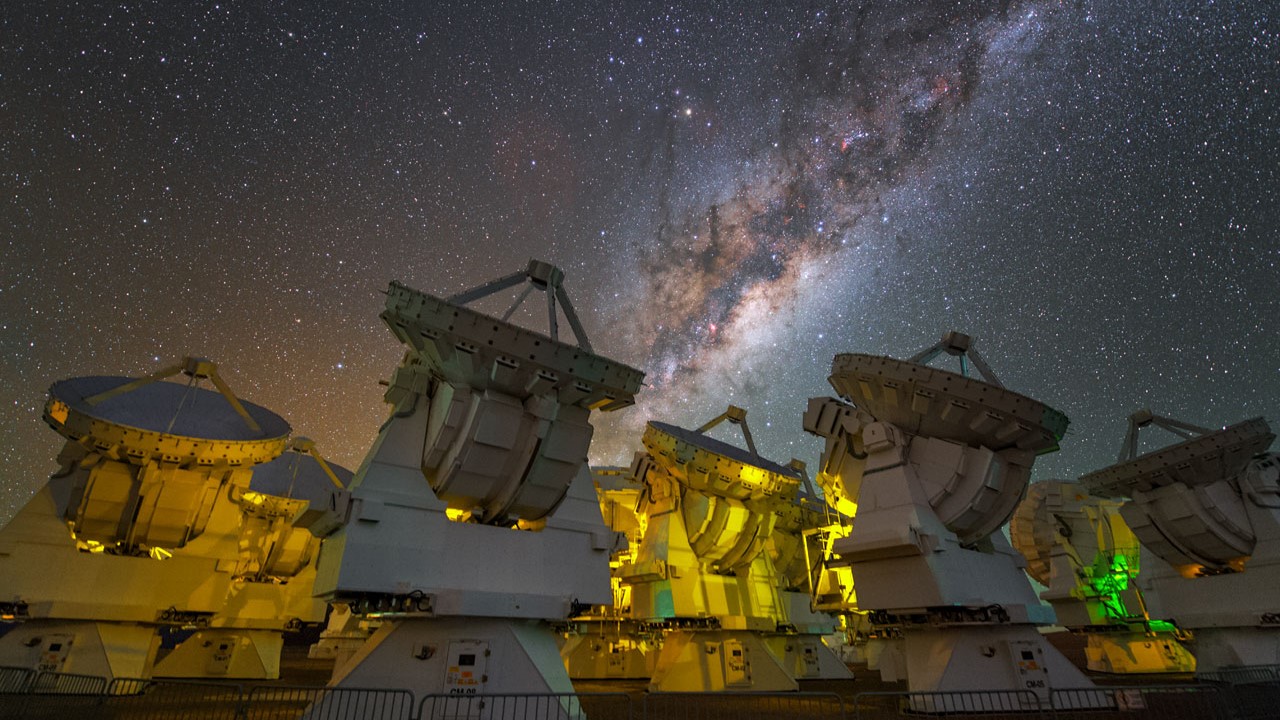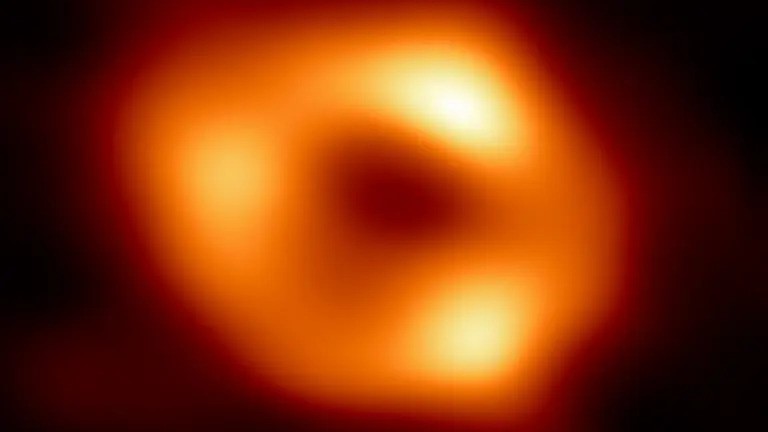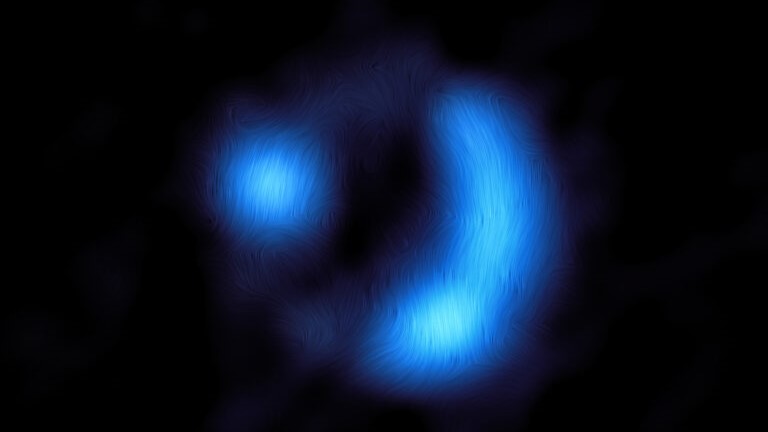Atacama Large Millimeter/submillimeter Array (ALMA) radio telescope: How it works and top discoveries
From learning the chemistry and structure of planet-forming disks around young stars to helping to produce the first images of black holes, ALMA has proved to be a prodigious astronomical tool.

The Atacama Large Millimeter/submillimeter Array (ALMA) is a collection of radio telescopes in Chile's Atacama Desert.
ALMA detects radio emissions at short wavelengths ranging from 0.32 to 8.5 millimeters (a frequency of 950 to 35 GHz). Emission at these wavelengths comes from some of the coldest objects in space, such as interstellar gas clouds and nascent protoplanetary disks.
How many antennae does ALMA have?
ALMA includes 66 antennae split into groups. The 12-Meter Array consists of 50 39-foot (12 meters) radio dishes that are used for high-resolution imaging. Another 12 antennae are 23-foot (7 m) dishes that form the 7-Meter Array, also known as the Atacama Compact Array or the Morita Array after the late Japanese astronomer Koh-ichiro Morita, who was a member of the Japanese ALMA team. The Morita Array is complemented by four additional 12-meter dishes that on their own are called the Total Power Array and measure the intensity of radio waves coming from celestial objects.
How does ALMA work?
ALMA's 66 antennae do not work individually. Instead, together they form what is known as an interferometer, which describes how they operate as a single unit or as several smaller units, combining their light using a technique known as aperture synthesis. As the name suggests, this "synthesizes" a giant-aperture telescope equivalent to the widest baseline between the two most distant antennae in the ALMA interferometer, which can be up to 10 miles (16 kilometers) apart. This maximum baseline between opposite ends of the array can be shortened by moving the antennae, with different configurations of antennae being used for different targets.
For ALMA's aperture synthesis to work, the millimeter and submillimeter light that each antenna detects must be sent along optical fibers to arrive at ALMA's main computer synchronously and perfectly in phase to within an accuracy of a few hundredths of a millimeter, similar to the diameter of a human hair. This main computer correlates the signals from each antenna so they can be combined into a single high-resolution image. These technical capabilities enable ALMA to image objects such as protoplanetary disks forming new worlds around young stars.
To accomplish this, ALMA's antennae have to be at their widest separation, giving ALMA an angular resolution — the smallest feature it can see in the night sky — of 0.004 arcseconds. To get a sense of how small that is, consider that the celestial equator, which mirrors in the sky the location of Earth's equator, is split into 360 degrees. Each degree can then be subdivided into 60 "arcminutes," and each arcminute can be further divided into 60 arcseconds. So 1 arcsecond is 1/3600 of an angular degree on a protractor. ALMA's greatest resolution is 0.0025 arcsecond.
Where is ALMA?
ALMA is located on the Chajnantor Plateau, 16,400 feet (5,000 m) above sea level, in the Chilean Andes. Its latitude of 30 degrees south ensures that ALMA has a clear view of the Milky Way overhead, as well as important targets, such as the Magellanic Clouds. Despite being in Chile, ALMA is not particularly close to other Chile-based observatories, such as the European Southern Observatory's Very Large Telescope, which is a six-hour drive to the west. ALMA is situated in the Atacama Desert, one of the driest places on Earth; astronomers who work with ALMA do so from their headquarters in the Chilean capital of Santiago.
Breaking space news, the latest updates on rocket launches, skywatching events and more!
The Chajnantor Plateau was chosen as ALMA's location because of its fantastically dry conditions and distance from urban areas that could cause interference with stray radio signals. The dry conditions are exceptionally important because water vapor in the atmosphere can lead to fluctuations in the signal that can build up and make it impossible to correlate the signals from the different antennae for aperture synthesis.
At one time, it was possible for the public to go on guided tours of ALMA, but these tours are not currently possible; only a few types of visitors are permitted.
ALMA's top discoveries
Since it began science operations in September 2011, ALMA has enabled scientists to make many important findings about the cosmos. Here are some of ALMA's biggest discoveries.
The distance record for oxygen molecules
ALMA has broken the record for the most distant oxygen ever seen several times. In 2018, a team used ALMA to detect oxygen in a galaxy that we see as it existed just 13.1 billion years ago, or less than 700 million years after the Big Bang. A few months later, ALMA found oxygen in a galaxy that existed less than 600 million years after the Big Bang.
And in 2018, a group detected oxygen just 250 million years after the Big Bang. The discovery was important for several reasons. First, it reveals that there must have already been several generations of stars by this early point in the universe because oxygen is formed in stars and released into space when they die. Second, because oxygen is a vital component for life, its presence near the beginning of the universe indicates that at least one important element of life was present at that time.
Images of protoplanetary disks
ALMA is the perfect instrument for detecting the cold dust and gas in disks forming planets around young stars. Such disks had been imaged before, particularly in infrared light. However, when ALMA observed the disk around the young star HL Tauri in 2014, it showed concentric rings in the disk, separated by gaps carved out by unseen planets still forming. Since then, ALMA has gone on to image plenty more protoplanetary disks and, in 2018, released a collection of 20 images.
The speed with which the disks evolve and form gaps suggests that giant planets form much faster than theory had predicted. The details that ALMA can detect include gravitational instabilities and differences in the orbital velocity of parts of a disk that can hint at how these planets are forming. ALMA even detected, for the first time ever, a protoplanetary disk around a star in another galaxy — specifically, the Large Magellanic Cloud.
Images of black holes
ALMA is a member of the Event Horizon Telescope project, a giant interferometer that incorporates telescopes from the Antarctic all the way up to Greenland. In 2019, the first image of a black hole — specifically, the supermassive black hole at the heart of the elliptical galaxy M87. This was followed up in 2022 by an image of Sagittarius A*, the supermassive black hole at the center of the Milky Way. ALMA contributed to both images and helped pave the way for observations of the black holes at a shorter wavelength of 0.87 mm, which improves the resolution of the black hole images by up to 50%.
An ancient magnetic field
Magnetic fields are all over the universe, and ALMA detected the most ancient magnetic field yet, in a galaxy that we see as it existed a little over 11 billion years ago, when the universe was just over 2.5 billion years old (compared with its current age of 13.77 billion years). ALMA detected the submillimeter emission from dust grains in this galaxy, called 9io9, but this emission was polarized. In other words, magnetic fields were causing the submillimeter electromagnetic radiation to oscillate in a preferred direction.
Every galaxy has its own magnetic field, and 9io9's is 1,000 times weaker than Earth's magnetic field, though it's spread across 16,000 light-years. The discovery is important because it helps tell astronomers how quickly galaxies' magnetic fields formed, what role magnetized regions of star formation inside giant molecular clouds played in this, and how the magnetic fields influenced subsequent star formation.
The detection of such an ancient magnetic field shows ALMA's incredible power, especially when the array is operating at its maximum baseline. "No other telescope could have achieved this," Jim Geach, an astrophysicist at the University of Hertfordshire in the U.K., said in a statement about the discovery.
Chemistry of life
ALMA specializes in detecting various molecules in interstellar gas clouds, and it has revealed a cosmos full of organic chemistry that could act as a precursor to the more complex molecules necessary for life. Complex organic molecules are defined as molecules that contain six or more atoms, with at least one of them carbon.
For example, in 2017 astronomers used ALMA to probe the young multiple-star system IRAS 16293-2422, which lies about 400 light-years away. ALMA detected methyl isocyanate in the protoplanetary disk around one young star in the system. Methyl isocyanate is important because it is involved in the formation of peptides and amino acids, which are vital components of proteins that are needed for life as we know it.
ALMA also found complex organic chemistry around V883 Orionis, a star in the constellation Orion. V883 Ori is a protostar that recently had an outburst, sending a wave of heat pulsing through the protoplanetary disk surrounding it. This thermal wave caused organic molecules to sublimate from icy grains in the disk, and ALMA detected a host of them: methanol, acetone, acetaldehyde, methyl formate and acetonitrile.
And in 2022, ALMA detected the most complex organic molecule yet found in a protoplanetary disk. The molecule, dimethyl ether, is composed of nine atoms and was discovered around the star Oph-IRS 48, which is 400 light-years away. Dimethyl ether is an important molecular component of even more complex organic molecules essential for life as we know it.
Plus, it's not only our galaxy that has interesting chemistry for life. ALMA also detected methyl formate in two dense, star-forming cores of molecular gas in the Large Magellanic Cloud. With these discoveries, ALMA is showing us that the basic building blocks of life are spread across the universe.
Additional resources
Take a virtual tour of ALMA, including its 66 radio dishes on the Chajnantor Plateau and the surrounding environment and wildlife.
Two more important submillimeter telescopes are located on Mauna Kea in Hawaii. Discover more about the Submillimeter Array and the James Clerk Maxwell Telescope.
Learn more about submillimeter astronomy from this explainer from the Arizona Radio Observatory.
Bibliography
ESO, 'ALMA: In Search of Our Cosmic Origins', https://www.eso.org/public/unitedkingdom/teles-instr/alma/
Antonio Hales, 'ALMA Cycle 11 Technical Handbook, Chapter 2: Array Components' (2024) https://almascience.eso.org/documents-and-tools/cycle11/alma-technical-handbook
ALMA Basics, https://almascience.eso.org/about-alma/alma-basics
'ALMA Compact Array Completed and Named After Japanese Astronomer', ESO (2013), https://www.eso.org/public/unitedkingdom/announcements/ann13040/?lang
ALMA Observatory Announcement, ACA Total Power Array Spectrometer PDR (2017), https://www.almaobservatory.org/en/announcements/aca-total-power-array-spectrometer-pdr/
'ALMA and Interferometry', ESO, https://www.eso.org/public/unitedkingdom/teles-instr/alma/interferometry/
Yoshiharu Asaki et al, 'Astronomical Radio Interferometry', Nature Reviews Methods Primers, 3, 89, (2023), https://www.nature.com/articles/s43586-023-00273-4
'How ALMA Works', https://www.almaobservatory.org/en/about-alma/how-alma-works/
'ALMA In-Depth: How Will ALMA Makes Images?', ALMA Newsletter, number 5, (April 2010) https://www.almaobservatory.org/wp-content/uploads/2017/06/05_how_will_alma_make_images.pdf
'Arcsecond', COSMOS: The SAO Encyclopedia of Astronomy, https://astronomy.swin.edu.au/cosmos/A/Arcsecond
'Privileged Location', https://www.almaobservatory.org/en/about-alma/privileged-location/#:~:text=This%20is%20why%20the%20ALMA,on%20Earth%20for%20astronomic%20observation.
B. Nikolic et al, 'Phase Correction for ALMA with 183 GHz Water Vapour Radiometers', Astronomy & Astrophysics, 552 (2013), https://www.aanda.org/articles/aa/full_html/2013/04/aa20987-12/aa20987-12.html
'Public Visits to the ALMA Operations Support Facility', ESO, https://www.eso.org/public/unitedkingdom/about-eso/visitors/alma/
'Visits', ALMA Observatory, https://www.almaobservatory.org/en/visits/
Akio K. Inoue et al, 'Detection of an Oxygen Emission Line From a High-Redshift Galaxy in the Reionization Epoch', Science, 352, No. 6293 (2016), https://www.science.org/doi/10.1126/science.aaf0714
N. Laporte et al, 'Dust in the Reionization Era: ALMA Observations of a z = 8.38 Gravitationally Lensed Galaxy', The Astrophysical Journal Letters, 837, 2, (2017), https://iopscience.iop.org/article/10.3847/2041-8213/aa62aa
Takuya Hashimoto et al, 'The Onset of Star Formation 250 Million Years After the Big Bang', Nature, 557, 392–395 (2018), https://www.nature.com/articles/s41586-018-0117-z
ALMA Partnership et al, 'The 2014 ALMA Long Baseline Campaign: First Results from High Angular Resolution Observations Toward the HL Tau Region', The Astrophysical Journal Letters, 808, 1 (2014), https://iopscience.iop.org/article/10.1088/2041-8205/808/1/L3
Sean M. Andrews et al, 'The Disk Substructure at High Angular Resolution Project (DSHARP): 1. Motivation, Sample, Calibration and Overview', The Astrophysical Journal Letters, 869, 2 (2018), https://iopscience.iop.org/article/10.3847/2041-8213/aaf741
Jessica Speedie et al, 'Gravitational Instability in a Planet-Forming Disk', Nature, 633, 58–62 (2024), https://www.nature.com/articles/s41586-024-07877-0
Anna F. Mcleod et al, 'A Probable Keplerian Disk Feeding an Optically Revealed Massive Young Star', Nature, 625, 55–59 (2024), https://www.nature.com/articles/s41586-023-06790-2
The Event Horizon Telescope Collaboration et al, 'First M87 Event Horizon Telescope Results: 1. The Shadow of the Supermassive Black Hole', The Astrophysical Journal Letters, 875, 1 (2019), https://iopscience.iop.org/article/10.3847/2041-8213/ab0ec7
Event Horizon Telescope Collaboration et al, 'First Sagittarius A* Event Horizon Telescope Results: 1. The Shadow of the Supermassive Black Hole in the Center of the Milky Way', The Astrophysical Journal Letters, 930, 2 (2022), https://iopscience.iop.org/article/10.3847/2041-8213/ac6674
Alexander W. Raymond et al, 'First Very Long Baseline Interferometry Detections at 870 μm', The Astronomical Journal, 168, 3 (2024), https://iopscience.iop.org/article/10.3847/1538-3881/ad5bdb
ESO, 'EHT Scientists Make Highest-Resolution Observations Yet from the Surface of Earth', 27 August 2024, https://www.eso.org/public/news/eso2411/
J. E. Geach et al, 'Polarized Thermal Emission from Dust in a Galaxy at Redshift 2.6', Nature, 621, 483–486 (2023) https://www.nature.com/articles/s41586-023-06346-4
ALMA, 'Furthest Ever Detection of a Galaxy's Magnetic Field' (6 September 2023), https://www.almaobservatory.org/en/press-releases/furthest-ever-detection-of-a-galaxys-magnetic-field/
R. Martín-Doménech et al, 'Detection of Methyl Isocyanate (CH3NCO) in a Solar-type Protostar', Monthly Notices of the Royal Astronomical Society, 469, 2 (2017) https://academic.oup.com/mnras/article/469/2/2230/3737681?login=false
Jeong-Eun Lee, 'The Ice Composition in the Disk Around V883 Ori Revealed by its Stellar Outburst', Nature Astronomy, 3, 314–319 (2019), https://www.nature.com/articles/s41550-018-0680-0
Nashanty G. C. Brunken et al, 'A Major Asymmetric Ice Trap in a Planet-forming Disk III: First Detection of Dimethyl Ether', Astronomy & Astrophysics, 659, A29 (2022), https://www.aanda.org/articles/aa/full_html/2022/03/aa42981-21/aa42981-21.html
Marta Sewiło et al, 'The Detection of Hot Cores and Complex Organic Molecules in the Large Magellanic Cloud', The Astrophysical Journal Letters, 853, 2 (2018), https://iopscience.iop.org/article/10.3847/2041-8213/aaa079

Keith Cooper is a freelance science journalist and editor in the United Kingdom, and has a degree in physics and astrophysics from the University of Manchester. He's the author of "The Contact Paradox: Challenging Our Assumptions in the Search for Extraterrestrial Intelligence" (Bloomsbury Sigma, 2020) and has written articles on astronomy, space, physics and astrobiology for a multitude of magazines and websites.







